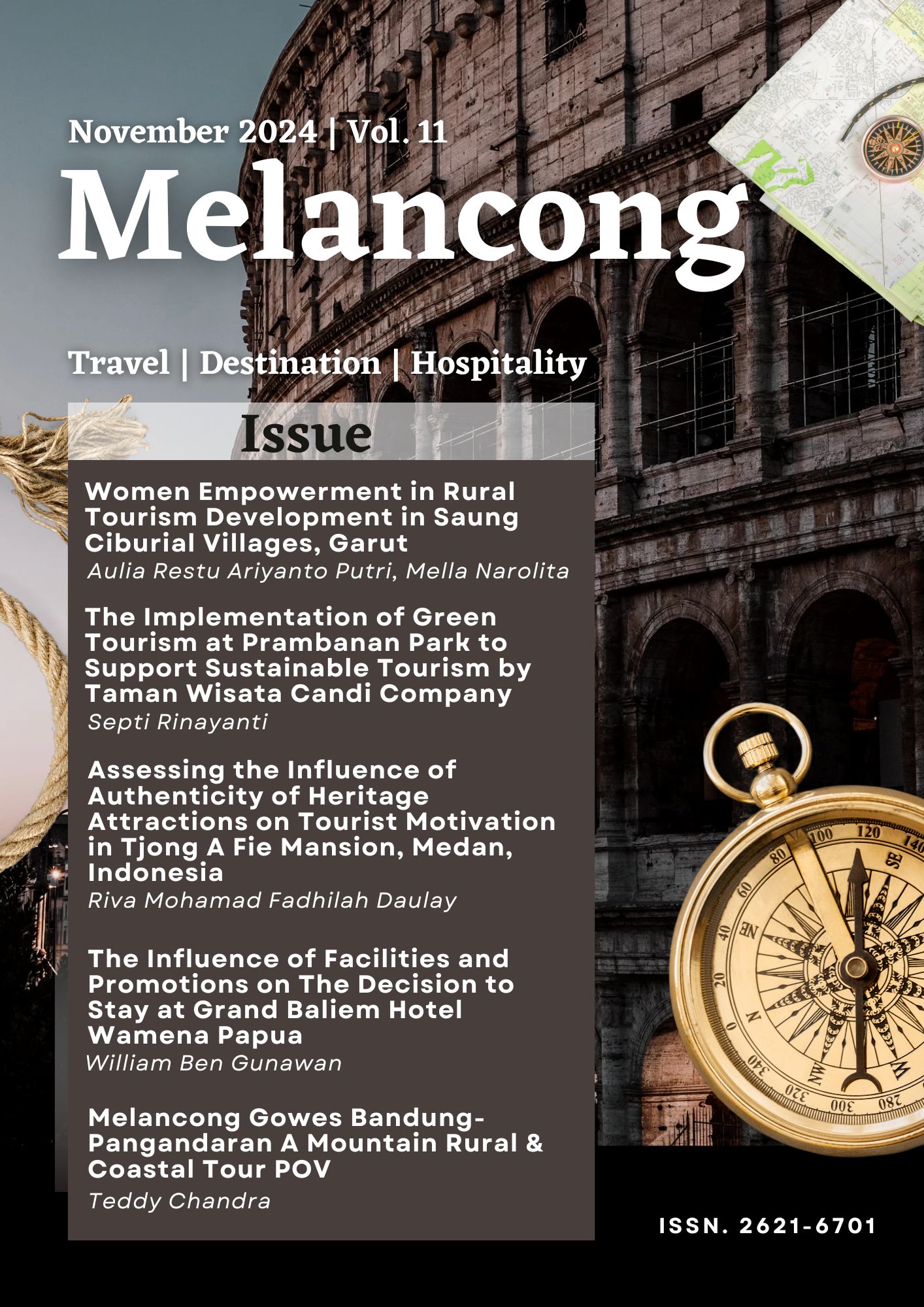Assessing the Influence of Authenticity of Heritage Attractions on Tourist Motivation in Tjong A Fie Mansion, Medan, Indonesia
DOI:
https://doi.org/10.21009/melancong.111.04Keywords:
Authenticity of Tourism Attraction, Tourist Motivation, Cultural Tourism, Heritage TourismAbstract
The purpose of this study was to determine the attraction’s authenticity in Tjong A Fie Mansion, tourist’s motivation to visit, and to find out the relationship between authenticity of the attraction to the motivation of tourist visits in Tjong A Fie Mansion. This study used a descriptive method with a quantitative approach using simple linear regression analysis . Data collection was carried out by distributing questionnaires to 103 respondents online with the target tourist respondents who had visited Tjong A Fie Mansion within a maximum period of 2 years after the time the study was conducted. Based on the results of the study, it was found that the authenticity of tourist attraction has a positive effect on tourist motivation of 56.9%. The implication of this research is that the authenticity of the attraction is a vital element for a tourist attraction such as museum. Therefore, efforts to present authenticity are deemed very important. The better the presentation and proof of the authenticity of the attraction, the greater the motivation of tourists to visit and see the attraction.
References
Boyd, S. (2001). Cultural and heritage tourism in Canada: Opportunities, principles and challenges. Tourism and Hospitality Research, 3(3). https://doi.org/10.4324/9781315239248-8
Chhabra, D. (2012). Authenticity Of The Objectively Authentic. In Annals of Tourism Research (Vol. 39, Issue 1). Elsevier Ltd. https://doi.org/10.1016/j.annals.2011.09.005
Ginting, N., & Rahman, N. V. (2016). Maimoon Palace Heritage District in Medan , Indonesia : What we preserve and why we preserve? Procedia - Social and Behavioral Sciences, 222, 332–341. https://doi.org/10.1016/j.sbspro.2016.05.177
Jamal, T., & Hill, S. (2002). The Home and the World: (Post)touristic Spaces of (In)authenticity? In G. M. S. Dann (Ed.), The Tourist as a Metaphor of the Social World (pp. 77–107).
Knudsen, B. T., & Waade, A. M. (2010). Re-Investing authenticity Tourism, Place and Emotions. In Channel View Publications. Channel View Publications.
Kolar, T., & Zabkar, V. (2010). A consumer-based model of authenticity: An oxymoron or the foundation of cultural heritage marketing? Tourism Management, 31(5), 652–664. https://doi.org/10.1016/j.tourman.2009.07.010
Mckercher, B. (2002). Towards a Classifcation of Cultural Tourists. International
Journal of Tourism Research, 38. https://doi.org/10.1002/jtr.346 Mckercher, B., & Du Cros, H. (2002). Cultural tourism: The partnership between tourism and cultural heritage management. In Cultural Tourism: The Partnership Between Tourism and Cultural Heritage Management (1st ed.). The Haworth Press. https://doi.org/10.4324/9780203479537 Mckercher, B., & Du Cros, H. (2015). Cultural Tourism, Second Edition (2nd ed.). Routledge.
Morrison, A. M. (2019). MARKETING AND MANAGING TOURISM DESTINATIONS. In Journal of Chemical Information and Modeling (2nd ed., Vol. 53, Issue 9). Routledge. https://doi.org/10.1017/CBO9781107415324.004
Nababan, C. R. (2013). Analisis Program Publisitas Wisata Budaya Tjong A Fie Mansion Dalam Meningkatkan Jumlah Wisatawan Domestik. Jurnal Ilmu Komunikasi Flow, 1(3), 1–15.
Nasution, J. (2018). Transformasi Modernitas di Kota Medan : Dari Kampung Medan Putri Hingga Gemeente Medan. Jurnal Sejarah, 1(2), 65–83.
Nguyen, T. H. H., & Cheung, C. (2016). Chinese heritage tourists to heritage sites : what are the effects of heritage motivation and perceived authenticity on satisfaction ? Asia Pacific Journal of Tourism Research, 1665(April). https://doi.org/10.1080/10941665.2015.1125377
Reisinger, Y., & Steiner, C. J. (2006). Reconceptualizing object authenticity. Annals of Tourism Research, 33(1), 65–86. https://doi.org/10.1016/j.annals.2005.04.003
Richards, G. (2018). Cultural tourism: A review of recent research and trends. Journal of Hospitality and Tourism Management, 36, 12–21. https://doi.org/10.1016/j.jhtm.2018.03.005
Rickly, J. M., & Vidon, E. S. (2018). Introduction: From Pseudo-Events to Authentic Experiences. In Authenticity & Tourism: Materialities, Perceptions, Experiences (1st ed., Vol. 24, pp. 1–12). Emerald Publishing Limited.
Sugiyono. (2015). Metode Penelitian Kombinasi (Mix Methods). Alfabeta.


